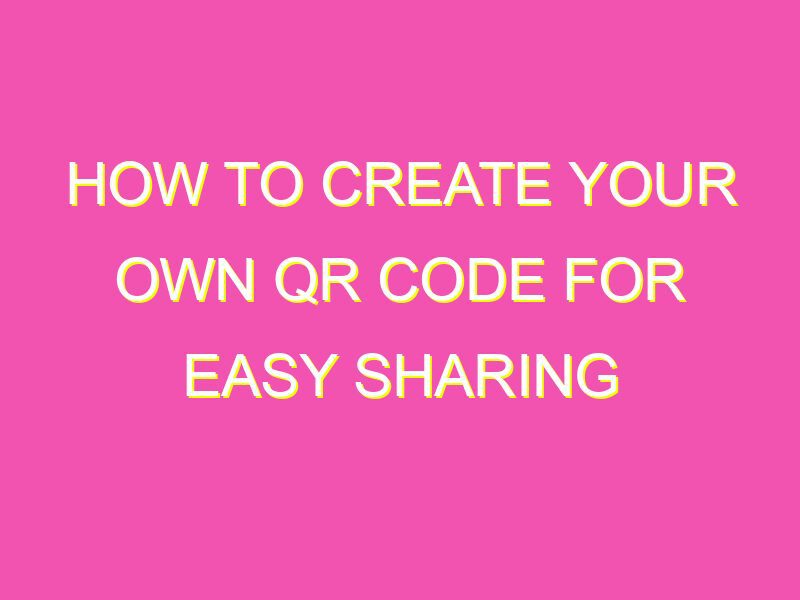Quickly and easily share information with others using QR codes. Follow these simple steps to create your own in just minutes:
By creating your own QR code, you can quickly and easily share information on the go – from business cards to flyers and beyond! So why not give it a try and experience the ease and accessibility firsthand?
How to Create Your Own QR Code – A Comprehensive Guide
Understanding QR Codes
QR codes have become increasingly popular over the years, and for good reason. A QR (Quick Response) code is a two-dimensional barcode that can be easily scanned using a smartphone or tablet camera. It consists of small, black and white squares arranged on a white background. These codes can be used to store a variety of information, such as website URLs, product information, contact details, and more.
Benefits of Using QR Codes
QR codes offer many benefits, both for businesses and consumers. Some of the key benefits of using QR codes include:
- Easy to use: QR codes can be quickly and easily scanned using a smartphone camera, with no need for typing in long URLs or other information
- Cost-effective: QR codes can be created for free or at a low cost, making them a cost-effective marketing tool for businesses
- Increased engagement: By scanning a QR code, customers can be taken directly to a specific product or service, increasing engagement and potential sales
- Trackable: QR codes can be tracked, providing valuable insights into consumer behavior
Different Types of QR Codes
There are a variety of QR code types that can be used to store different types of information. Some of the most common types include:
- URL: Used to direct users to a specific website URL
- Contact: Used to store contact information, such as a phone number or email address
- Text: Used to store plain text information
- WiFi: Used to connect users to a specific WiFi network
- Geo Location: Used to provide users with specific location-based information, such as a map or directions
Steps to Create a QR Code
Creating a QR code is a relatively simple process. Here are the basic steps:
- Choose a QR code generator. There are many free and paid options available online, such as QR-Code Generator, QRStuff, and QR Code Monkey
- Select the type of QR code you want to create
- Enter the information you want to store in the code, such as a URL or contact information
- Customize the design of the QR code, if desired
- Download and save the QR code as an image file
Tips for Creating an Effective QR Code
While creating a QR code is relatively easy, it’s important to ensure that it is effective in achieving its intended purpose. Some tips for creating an effective QR code include:
- Make it mobile-friendly: Ensure that the content that the QR code is linking to is mobile-friendly and easy to view on a smartphone or tablet
- Test it: Before distributing your QR code, test it to ensure that it is functioning properly and provides a positive user experience
- Provide context: Consider providing context for the QR code, such as explaining what the user can expect to find by scanning it
- Optimize placement: Place the QR code in a prominent and easily accessible location, such as on a store display or product packaging
Best Practices for Using QR Codes
To ensure a positive user experience and effective use of QR codes, it’s important to follow some best practices, such as:
- Keep it simple: Avoid using complex URLs or information, as this can make it difficult for users to scan and access the content
- Provide value: Ensure that the content the QR code links to provides genuine value to the user, such as exclusive offers or product information
- Track and measure: Use tracking tools to gather valuable insights into scan rates and user behavior, and adjust your QR code strategy accordingly
Potential Uses for QR Codes
QR codes can be used in a variety of ways across different industries and sectors. Some potential uses for QR codes include:
- Marketing: By linking to product information or special offers, QR codes can be used as a marketing tool to engage customers and drive sales
- Logistics: QR codes can be used to track and manage inventory, making logistics and supply chain management more efficient
- Event Management: QR codes can be used as event tickets or conference badges, making event management and attendance tracking more streamlined
- Education: QR codes can be used in educational materials and textbooks to link to additional resources or multimedia content
In conclusion, QR codes are a simple yet effective tool that can be used to provide additional value and engagement to customers. By following best practices and considering different types and uses, businesses can leverage QR codes to their full potential. With the ease of creating a QR code, it’s worth taking the time to explore the possibilities and see how they can be implemented in your marketing and operations strategy.





